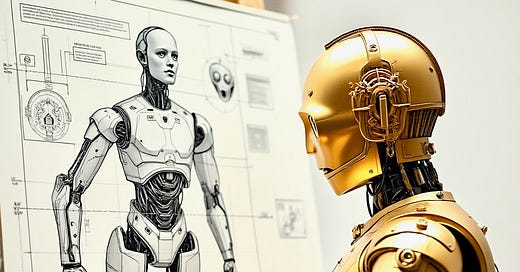Market Disruptors: Enter The Humanoid Robots
They’ll force us to rethink almost everything, including Economics
An early meeting this morning was in London’s Mayfair, with RethinkX, whose work has inspired my own for many years. While there, I woke up to the fact that, while I mention their latest report on humanoid robots in many of my talks, I haven’t said anything here as part of this Rewilding Markets series of posts. And given that their project launched early last year, that’s quite an oversight.
So, particularly given that humanoid robots appear in so many of the illustrations in these posts, thanks to my use of visual AI, I thought I should at least acknowledge RethinkX’s robotic thinking. And, as a taster for anyone who hasn’t yet come across or fully digested their research, let me trail just six out of the 15 insights they offer about the impact that robots are likely to have on our world and our futures.
An inevitable disruption
First, the RethinkX team concludes, the disruption of labor markets by humanoid robots is inevitable, unstoppable. These machines, they forecast, will enter the market at a cost-capability of under $10/hour for their labor, then head along an inexorable trajectory down to under $1/hour before 2035—reaching under $0.10/hour before 2045
Throughout history, they say, “every time technology has enabled a 10x or greater cost reduction relative to the incumbent system, a disruption has always followed. This figure alone makes the disruption of a substantial fraction of human labor inevitable.”
Then, second, they believe that this disruption will create an entirely new labor system.
“Humanoid robots won’t just displace human jobs,” they predict. “Instead, they will create an entirely new—and vastly larger and more capable—labor system.
The key feature of this system, we are told, is that “the marginal cost of labor will rapidly approach zero. This is what we call a phase change disruption.”
And what is remarkable about such phase change disruptions is that they “create entirely new and much larger systems, with new properties, new business models, and new metrics, just like when the Internet and digital technologies reduced the marginal cost of information and communications to near-zero.”
Productivity will skyrocket
Which bring us to their third insight. This is that this disruption will be about tasks not jobs.
“So long as humanoid robots are not sentient, they will not have jobs,” we are told. “They will only perform tasks. Most jobs involve much more than performing a single task. They typically entail responsibility for a range of tasks, each of which requires a different amount of training, experience, and skill to perform.”
They continue: “The disruption of labor, with all of its world-changing implications, can therefore only be understood with tasks as the correct unit of analysis, and tasks per hour per dollar as the corresponding cost-capability metric.”
On the upside, in the fourth insight in our sequence, though it’s #6 for them, they argue that “productivity will skyrocket.” Which is pretty high on the wish-lists of many governments at the moment.
Many tasks that could hitherto only be performed by a limited supply of suitably trained adult humans will soon be performed far more cheaply and effectively by humanoid robots.
A key to a successful economic and societal transition, RethinkX suggests, will be the “autocatalysis of humanoid robot production,” where today’s AI-powered robots are used to design and manufacture tomorrow’s variants. It makes sense, if you’re a roboticist or an economist, but it’s hard not to see this future as just slightly spooky.
Rethinking Economics
And there is no avoiding the bad news. “Technological unemployment remains inevitable,” RethinkX warns, “but latent demand for labor will be met first, creating a crucial planning window for a soft landing.”
In the near term, for maybe a decade or so, their analysis suggests, “humanoid robots will largely be deployed to meet demand for labor that is currently going unmet by humans—as opposed to directly displacing human workers from jobs they currently occupy.”
But when the disruption of labor by robots, humanoid or not, is complete, RethinkX argues that we will need to “rethink economics itself because fundamental notions like scarcity and exogenous total factor productivity will no longer hold. The labor engine (itself a new kind of ‘capital’) will become self-sustaining and self-expanding, and superabundance will become the rule rather than the exception.”
Such superabundance I suspect, will only be environmentally sustainable if we also make currently unimaginable progress in evolving truly circular economies, at a time when the statistics suggest that we are actually becoming less circular.
Like most modern technologies, it seems certain, robots will become cheaper and more powerful over time. Indeed, perhaps the most memorable line in the RethinkX analysis runs as follows:
“Humanoid robots today are the most expensive and least capable they will ever be.”
John Elkington is Founder & Chief Pollinator at Volans. His personal website can be accessed here.
Available on Amazon and through good bookshops.






Besides the essential circular economy requirement, which you mention, the hardest transformation will be the political-economic system. When artificial labour becomes so cheap, how do we decouple having a job from meeting basic human needs? James Arbib and Tony Seba brainstorm some alternatives in their new book, Stellar (out soon), but I worry about the feasibility (given political and economic ideologies and institutional inertia).
It was brilliant discussing this all at RethinkX thanks John @JamieArbib @RichardGill